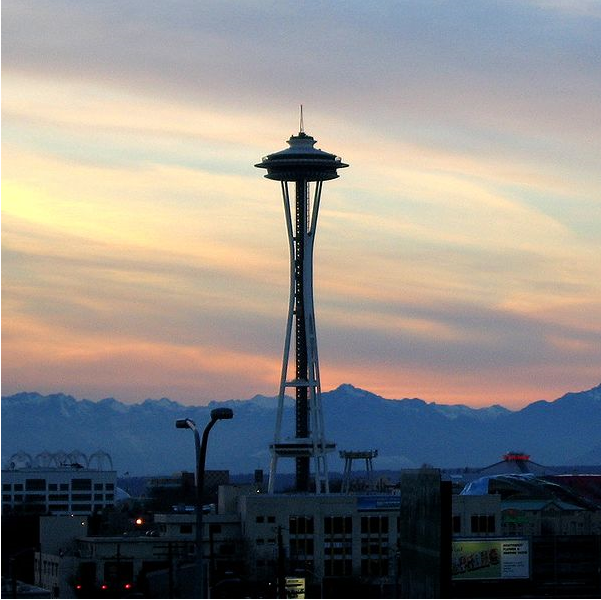The Space Needle
by Andrew Boyd
Today, a landmark in the clouds. The University of Houston's College of Engineering presents this series about the machines that make our civilization run, and the people whose ingenuity created them.
It's as inextricably linked with its home town as the Eifel tower is linked with Paris. Rising skyward, it's a 1960s vision of the twenty-first century. But the spire's design transcends the era of its birth. It's Seattle's Space Needle. And it almost wasn't built.

The Space Needle was the inspiration of Eddie Carlson, who considered it the pi'ce de r'sistance of the 1962 World's Fair. The Needle began as a doodle, but Carlson soon engaged the help of an architectural team. The team eventually settled on a graceful tripod topped by what can best be described as a flying saucer. The concept was elegant. But reality was about to set in.

King County, home to Seattle and the fair, refused to finance the structure, believing the county would never recover the 4.5 million dollars required for construction. City fathers quickly stepped up with private financing, but another problem remained: where to build the tower? It had to be located on or adjacent to the fairgrounds, but no such land was available. The Space Needle was all but dead when at the last minute the city made available a small 120' by 120' parcel of land — an old fire department alarm center. It was just enough. With less than a year remaining before the fair was scheduled to open, construction began.
We can only imagine the harried coordination that went into building the sixty story structure, complete with finished restaurant and observation deck. The last elevator was installed just the day before the fair opened. But the effort was worth it. The Space Needle was an immediate success, paying for itself in a matter of a few years. It's still privately owned, and the most visited attraction in the Pacific Northwest.
When finished, the Space Needle was the tallest building west of the Mississippi, with views stretching from the Cascade Mountains in the east to the Olympics in the west; from the towering Mount Rainier in the south to the volcanic Mount Baker in the north. Even today views are unimpeded by tall office buildings, since the Seattle Center, where the Space Needle resides, is a mile from downtown.

The Space Needle's foundation weighs as much as the tower, placing the center of gravity right at ground level. It's survived large earthquakes and 90 mile-an-hour winds without so much as a crack in the plaster.
When we think of Seattle, we think of Microsoft and Amazon; of Kurt Cobain and Frasier Crane; of cloudy days, cool rains, and warm cups of coffee. But when we visualize Seattle, it's that quiet sentinel that comes to mind — the beautiful, and beautifully engineered, Space Needle.
I'm Andy Boyd at the University of Houston, where we're interested in the way inventive minds work.

Notes and references:
The 1962 World's Fair was also known as the Century 21 Exposition. For more information, see the Wikipedia Web site: https://en.wikipedia.org/wiki/Century_21_Exposition. Accessed August 31, 2010.
Space Needle. From the History Link Web site: http://www.historylink.org/index.cfm?DisplayPage=output.cfm&File_Id=1424. Accessed August 31, 2010.
With the exception of the Seattle post card, photographed by E. A. Boyd, all pictures are from Wikimedia Commons.